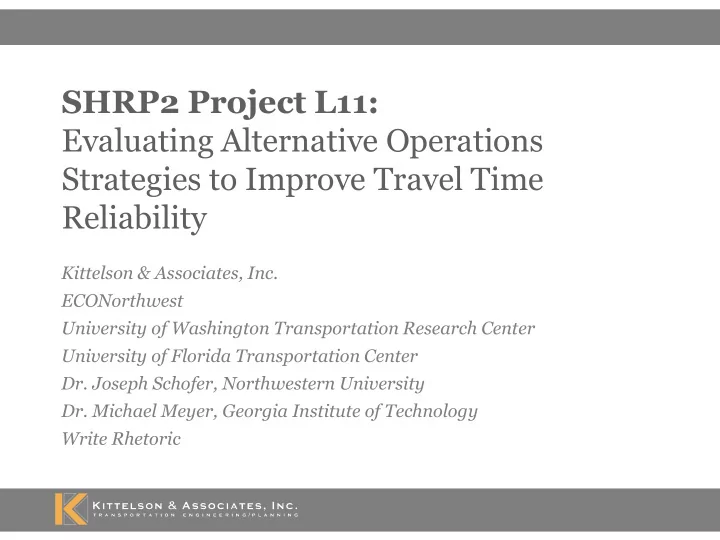

SHRP2 Project L11: Evaluating Alternative Operations Strategies to Improve Travel Time Reliability Kittelson & Associates, Inc. ECONorthwest University of Washington Transportation Research Center University of Florida Transportation Center Dr. Joseph Schofer, Northwestern University Dr. Michael Meyer, Georgia Institute of Technology Write Rhetoric
Presentation Overview Key project objectives and findings Strategies and trends affecting reliability Recommended steps to improving agency effectiveness Mainstreaming reliability: – Implementation road map – Recommended agency path Estimating the value of reliability
Project Objective Identify and evaluate strategies to meet road user reliability needs according to: – Travel type (person vs. freight) – Travel location (urban vs. rural) – Time scenario (near-term vs. long-term) Context for project findings and recommendations: – Degree of congestion is the overriding factor affecting reliability
New/Emerging Strategies Automation/Infrastructure – Road pricing, real-time control of transit arrivals, IntelliDrive, vehicle automation, automation in truck operations Information Technology/Data Sharing Technologies – Real-time system status and predictive models, weather detection and response, accessible vehicle probe data Integration/Cooperation – Customized real-time multimodal routing, crash detection and clearance, real-time parking, conditions, and routing information For each strategy, provide: Xxx strategies are identified - description - affected travel modes - impacts on reliability - implementation cost
Trends Affecting Travel Time Reliability Demographics – 40% population increase by 2030 Environment Technology – Climate is changing Energy Urban Sprawl Energy Costs – Petroleum costs will rise Reliability Technology & innovation – Energy and communication sources and costs Densification Privatization Freight – 90% increase in domestic tonnage Financing – Disconnect between supply and demand
Effectively Integrating Reliability into an Agency How is agency effectiveness measured? – Output measures (number of VMS signs, 511 calls, average incident duration) – Outcome measures (effect of actions on improved travel time reliability and/or reduced delay) What issues affect agency effectiveness? – Availability of and access to appropriate resources – Control/understanding over when, where, and how disruptions occur – Knowledge/training in when and how to apply resources – Feedback on results of past performance
Steps to an Effective Agency Operation 1. Incorporate Systems Operations and Management (SO&M) into Institutional Architecture Four Key Elements of Institutional SO&M: Application of ITS Architecture: strategies to maintain and improve highway System Operations and Management service in terms of (SO&M) Structure Awareness recurring and non- Establish SO&M Structure recurring congestion Establish SO&M as a High-Priority Budget Item Typical DOT Identify Public-Private Partnership Opportunities SO&M Where does it Planning Operations Design Maintenance SO&M fit in? SO&M
Steps to an Effective Agency Operation 2. Provide more accurate and accessible travel time information Probe vehicles and point detection Modified travel behavior: Surveillance and detection Departure time Pre-trip information Mode choice Real-time information Route choice Roadside messages Improved network capacity utilization and reliability
Steps to an Effective Agency Operation 3. Develop safer, more efficient, and more intelligent vehicles =
Steps to an Effective Agency Operation 4. Manage Incidents, Work Zones and Special Events – Pre-event - construction phasing - evacuation planning – Post-event - coordinated response - service patrols - Monitor and evaluate infrastructure to determine vulnerability
Steps to an Effective Agency Operation 5. Implement strategies and treatments to improve roadway performance Geometric design treatments Low-cost changes to the Access management physical roadway section Lane treatments Signal timing/ITS Traffic demand metering Strategies that influence and respond to demand Variable speed limits Congestion pricing Multimodal travel Reduce and encourage alternative travel Travel reduction
Agency Implementation Roadmap Political steps – Educate decision makers on need to balance demand and supply – Select accountability-based performance measures – Use pricing strategies to achieve performance outcomes – Participate in demand management programs Interagency steps – Create collaborative culture among agencies – Collect and share performance data – Encourage interaction with the private sector and trip generators Technology steps – Collect and share data with both public and private partners – Encourage private innovation and risk-taking
An Agency Path to Mainstreaming Reliability Introduce culture of service, innovation, and 1. partnerships Structure Prioritize projects per performance measures 2. Integrate Agency Path 3. Mode Jurisdiction Integration Functional responsibilities Data Public/Private Partnerships Deploy Current & New Technologies 4. User Options Integrate Technologies 5. Funding Trade fuel tax for fees-for-service funding 6.
Options Theoretic Approach Summary An options theoretic approach has been developed for the valuation of travel time reliability. This innovative approach is supported by theory and empirical estimations where travelers are willing to trade average travel time for lower travel time variability. • This approach has been successfully implemented in the travel demand model and benefit-cost analysis tool for a ECONorthwest for PSRC Transportation 2020 Travel Model and BCA runs. MPO.
Questions for the Audience What are the most problematic elements of the recommended agency path? What other steps should be included in the recommended agency path?
Recommend
More recommend